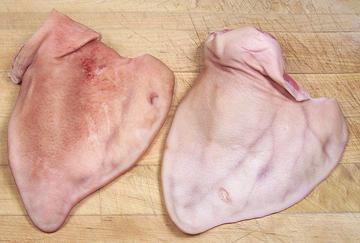 The photo at left shows typical pig ear cross sections, after cooking.
The outer layer skin can be cooked from firm to soft and the white
cartilage will remain crunchy, but it isn't hard to chew.
The photo at left shows typical pig ear cross sections, after cooking.
The outer layer skin can be cooked from firm to soft and the white
cartilage will remain crunchy, but it isn't hard to chew. Pig ears are eaten in almost every culture that eats pork - except for
"regular Americans", who tend to be uncomfortable eating any part of an
animal that resembles part of an animal.
Pig ears are eaten in almost every culture that eats pork - except for
"regular Americans", who tend to be uncomfortable eating any part of an
animal that resembles part of an animal.
The texture of pig ears is unusual. When cooked, the outside is firm but gelatinous, with a thin white crunchy core. The photo specimens were about 8-3/4 inches long, 6-5/8 inches wide and weighed a little over 12 ounces each.
More on Cuts of Pork and
Pigs.
 The photo at left shows typical pig ear cross sections, after cooking.
The outer layer skin can be cooked from firm to soft and the white
cartilage will remain crunchy, but it isn't hard to chew.
The photo at left shows typical pig ear cross sections, after cooking.
The outer layer skin can be cooked from firm to soft and the white
cartilage will remain crunchy, but it isn't hard to chew.